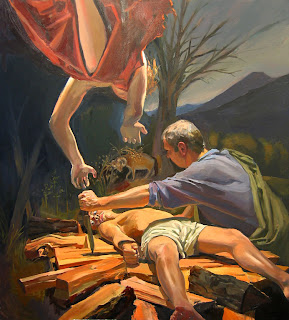Abraham lived some 6,000 years ago and the story of his life and how he treated his two sons lives on in the religious foundations of Islam, Judaism, and Christianity. And though there are variations in the stories, the main lines are remarkably consistent through all those years.
Here are the stories, relevant, in more ways than one, to the preset day.
 Sarah was 80 and Abraham was 86, and he had no heir. If he died, all his cattle and goods would pass to a male in his household (he had hundreds), but not an heir of his body. Not to be abided by. And Sarah would be left with nothing.What to do . . . what to do . . . .
Sarah was 80 and Abraham was 86, and he had no heir. If he died, all his cattle and goods would pass to a male in his household (he had hundreds), but not an heir of his body. Not to be abided by. And Sarah would be left with nothing.What to do . . . what to do . . . .Well, it turned out that Sarah has a good looking Egyptian slave, Hagar, and as luck would have it, the Law of Abraham (now most fiercely enforced by the Taliban) provided that if the head of a household bore a son by his wife's slave, it was just as if his wife had carried the child herself. Beautiful Hagar, of child-bearing age, was the solution
 But things never work out as they should. No sooner was Hagar pregnant than she got uppity, since sh e would bear the heir. Sarah was beside herself and demanded that Hagar be sent away. A voice that no one else could hear told Abraham to obey Sarah, and Hagar was banished to the wilderness.
But things never work out as they should. No sooner was Hagar pregnant than she got uppity, since sh e would bear the heir. Sarah was beside herself and demanded that Hagar be sent away. A voice that no one else could hear told Abraham to obey Sarah, and Hagar was banished to the wilderness.Their water bottle lay empty at their sides, and thurst was upon them.
 When suddenly, at the laast moment, an angel appeared.
When suddenly, at the laast moment, an angel appeared.

Baroque paainters liked angels.

The angel pointed to a spring of water just over rise!
The rest is history; actually, it is our current affairs.

For Ismael went on to become a famous archer, marry an Egyptian, have many sons, and found many tribes -- now the many tribes of the Arabs, whose Sharia, or Laws, is largely based on the Laws of Abraham, and each of whom carries Abraham's genes.
One can make the argument that the Arabs are warlike and chauvinistic because their ancestor, Ismael, was so badly treated by his father, Abraham. Indeed, their are a number of books on that very subject.
I don't make quite that argument. Bu I do think that for a religion such as Islam, Judaism, and Christianity to hold Abraham up as a positive role model tells us something damaging to the religions.
Isaac meekly carried the fagots up the mountain.
There are many paintings, done in careful detail, of Isaac's binding. Jesus' binding is also done with great attention to detail, as are the bonds of the many martyrs that Baroque painters liked to paint.









































